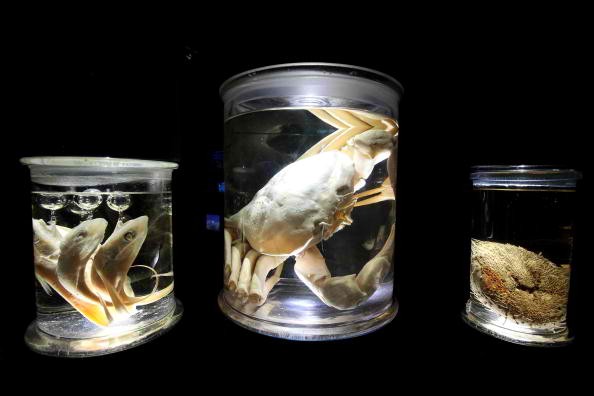Hoff Crab: 5 Interesting Things You Should Know About This Yeti Crab
| Ina Ariola | | Jun 26, 2015 05:27 PM EDT |
(Photo : Getty Images/Dan Kitwood ) Check out these five must-know facts about Kiwa tyleri, also known as "Hoff Crab."
White hairy crabs? Are they for real?
Of course they are! Meet the newest member of the Kiwaidae or yeti crab family, the "Hoff Crabs" or scientifically known as Kiwa tyleri.
These small creatures were found by a group of ecoligist from University of Southampton in 2010, while they were in search of a new yeti in Antarctica.
Like Us on Facebook
Still refusing to believe their existence? Let these five facts help you understand.
1. Origin of the name Hoff Crab and Kiwa tyleri.
The name "Hoff Crab" was taken from the "Baywatch" actor David Hasselhoff. These yeti crabs have similar characteristic with Hasselhoff — their chests are hairy too.
Meanwhile, its scientific name Kiwa tyleri was given to the species to honor Paul Tyler, a prominent British polar and deep-ocean biologist from Southampton University.
2. Hoff Crabs live in a hostile environment.
They are the only species of the yeti clan known to live in the Southern Ocean of Antarctica. They were found 2,000 meters below sea level, according to the report of National Geographic.
The water temperature down in East Scotia Ridge is about zero degrees Celsius. For these crabs to survive, they have to crowd around volcanic rock systems known as hydrothermal vents.
Here's the thing though, the heat of the vent can kill them if they get too close. On the other hand, they will freeze if they get too far.
As a result, they cluster together much closer compare to the other species.
3. Strange death happens to female yetis.
Researchers believe that yeti eggs can only be bred in a cooler environment. Sven Thatje, marine evolutionary ecology associate professor at the University of Southampton, said that the eggs would not survive if they are too close to the hydrothermal vents that emit sulfur.
This being said, mother yetis have to make a sacrifice, BBC News has learned. When she-crabs move out from the site to breed the eggs, they no longer feed, so they starve and eventually die.
4. Hoff Crabs have their own garden to grow their food.
Scientists found that yetis feed by growing food, bacteria, in their own yard. The hairs on their bodies are the perfect spot.
If they get hungry, they can just tug them off and ingest them. Their setae or hairs also permit them to remove bacteria growing on chimney vents, according to News Discovery.
5. Hoff Crabs' legs have spikes.
Spikes were found on ends of their legs, according to researchers. This distinct characteristic allows them to climb sheer surfaces.
Kiwa puravida and Kiwa hirsute, the other yeti species found living in the Pacific basin near Antarctica and Costa Rica, don't have this kind of advanced feature.
For more photos, see this link.
TagsHoff Crab, Scientific name, crab, Yeti Crab, listicle
©2015 Chinatopix All rights reserved. Do not reproduce without permission
EDITOR'S PICKS
-

Did the Trump administration just announce plans for a trade war with ‘hostile’ China and Russia?
-

US Senate passes Taiwan travel bill slammed by China
-

As Yan Sihong’s family grieves, here are other Chinese students who went missing abroad. Some have never been found
-

Beijing blasts Western critics who ‘smear China’ with the term sharp power
-

China Envoy Seeks to Defuse Tensions With U.S. as a Trade War Brews
-

Singapore's Deputy PM Provides Bitcoin Vote of Confidence Amid China's Blanket Bans
-

China warns investors over risks in overseas virtual currency trading
-

Chinese government most trustworthy: survey
-

Kashima Antlers On Course For Back-To-Back Titles
MOST POPULAR
LATEST NEWS
Zhou Yongkang: China's Former Security Chief Sentenced to Life in Prison

China's former Chief of the Ministry of Public Security, Zhou Yongkang, has been given a life sentence after he was found guilty of abusing his office, bribery and deliberately ... Full Article
TRENDING STORY

China Pork Prices Expected to Stabilize As The Supplies Recover

Elephone P9000 Smartphone is now on Sale on Amazon India

There's a Big Chance Cliffhangers Won't Still Be Resolved When Grey's Anatomy Season 13 Returns

Supreme Court Ruled on Samsung vs Apple Dispute for Patent Infringement

Microsoft Surface Pro 5 Rumors and Release Date: What is the Latest?










